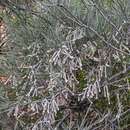en
names in breadcrumbs


Amyema gibberula is an aerial hemiparasitic plant of the family Loranthaceae native to Australia and found in Western Australia, the Northern Territory, and South Australia.[4][5]
It flowers in dyads (groups of two flowers) and usually has four petals.[4] The filaments of the stamens are shorter than the anthers of the stamen.[4] Its green, red, pink and white flowers can be seen from April to September or November to December.[6] The leaves are terete (cylindrical and long).[4]
A. gibberula is found on various species of Hakea and Grevillea.[6]
It was first described by Tate in 1886 as Loranthus gibberulus,[1][7] with its genus being changed to Amyema by Danser in 1992.[2]
Amyema gibberula is an aerial hemiparasitic plant of the family Loranthaceae native to Australia and found in Western Australia, the Northern Territory, and South Australia.